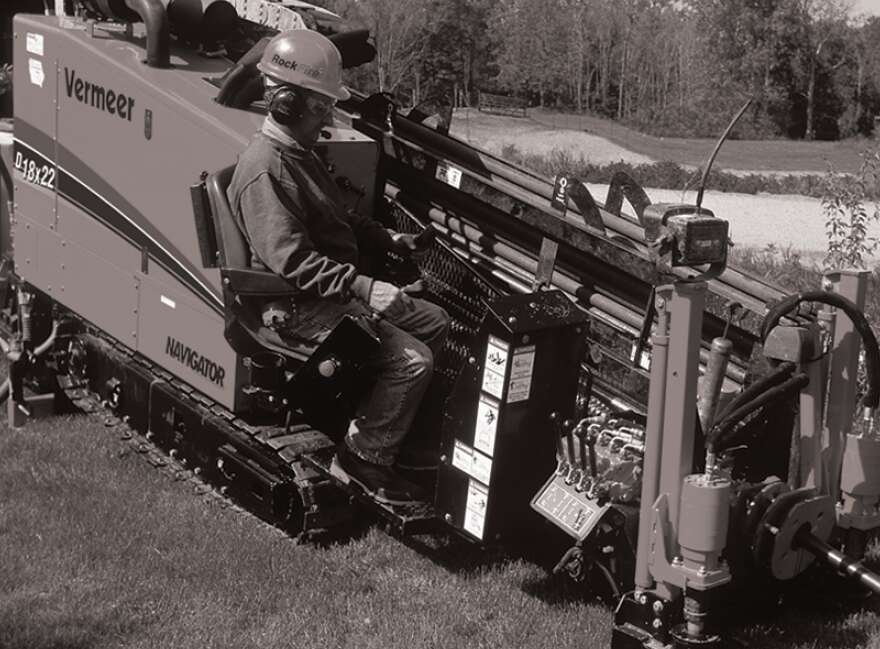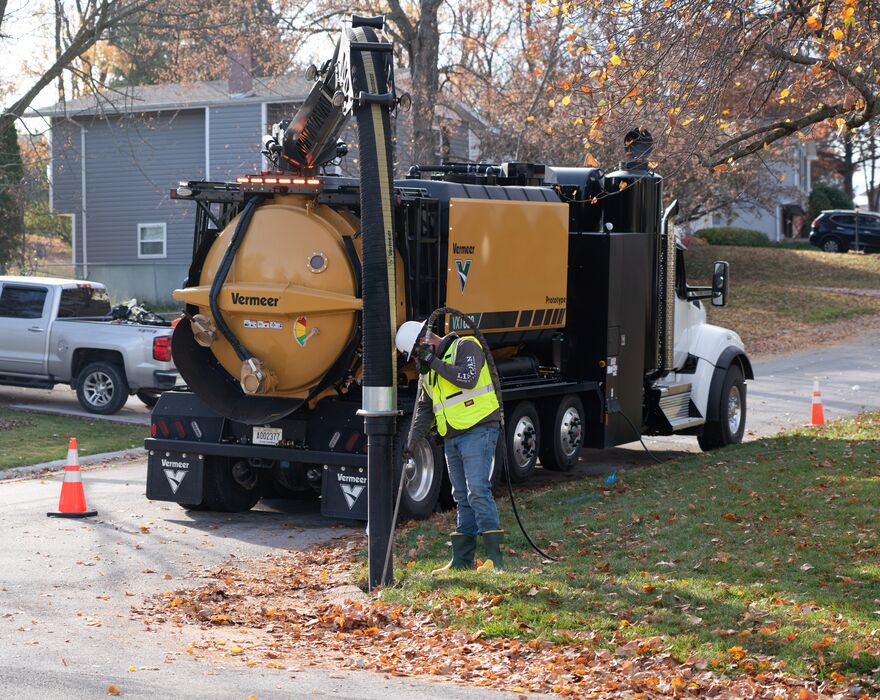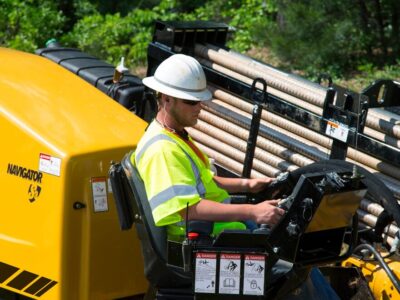Horizontal directional drilling (HDD) is a method used to install water and sewer lines, fiber cable, oil and gas pipelines or other infrastructure underground.
In the late 1980s, the concept of a pneumatic ground-piercing drill was discussed in the infrastructure industry. In 1991, Vermeer had built five units for dealers and customers to test. By 1993, the first self-contained drill was launched.

Thirty years later, jobsites have changed significantly — as well as equipment. Remaining unchanged is the growing market for HDD and the need to place even more infrastructure underground.
How is horizontal directional drilling different from other methods?
HDD is done in place of traditional open-cut trenching. It’s especially useful when working on jobsites that contain obstacles like roads, rivers, sidewalks or other urban areas where trenching would be disruptive. An often-overlooked benefit to HDD is that it is often preferred by the businesses and residents of the communities where work is being done. If installing infrastructure with a trencher on a busy city street, traffic would likely be halted, and local businesses could suffer. Not to mention, residents that live near where a trencher is doing work would likely experience insolvencies like noise, debris and closed-off areas.
What are the advantages of horizontal directional drilling?
HDD is one of the preferred methods to place infrastructure product underground for many reasons. Not only are there benefits like reduced jobsite costs, but improved crew safety, efficiency and installation accuracy as well.
- Minimized disruption: A benefit to using HDD is that there is less disruption to traffic, businesses and the environment. This is appealing especially in highly populated areas. Where obstacles like roads, rivers or bridges are present and traditional trenching would be impractical, a horizontal directional drill is ideal.
- Environmental impact: Since HDD disturbs the surface less than trenching or excavation, it reduces overall environmental impact. This is especially key in sensitive areas like wetlands and forests or habitats of endangered species.
- Jobsite versatility: A horizontal directional drill can be swapped with a wide variety of drill bits to tackle many soil conditions. This enables drillers to work with many soil compositions using the same machine.
- Comparative cost: While the initial purchase of a drill may be daunting, you can often save on your overall project costs. Drilling instead of open-cut trenching reduces the necessary restoration work and can shorten jobsite deadlines.
- Accurate installation: With the use of technology such as +BorePlan and underground locators, a horizontal directional drill can install product with improved accuracy. Accurate product installation promotes additional jobsite and operator safety by avoiding existing utilities.

What equipment is used for horizontal directional drilling?
There’s a variety of equipment that is necessary on an HDD jobsite. The model of equipment you run can enhance productivity due to features and technology.
Here’s a rundown of equipment:
- Pipeline drills: Larger HDDs, used to install large-diameter products like sewers, water and gas lines.
- Utility drills: Smaller HDDs that can be used to install larger product — like water, gas and power lines — as well as smaller-diameter products, like fiber and telephone lines.
- Locators: Tool used to identify the location and depth of underground infrastructure. Using a locator is essential to prevent damage to utilities and ensure the safety of HDD crews. Many state laws require all utilities to be located, marked and exposed before work begins — which makes a locator essential for nearly all HDD crews.
- Truck and trailer vacuum excavators: Also called hydro vacs, these machines combine a powerful vacuum with water to remove soil safely. Vacuum excavators are used to expose underground utilities without causing damage to the utility themselves — which is especially helpful in urban areas with robust underground infrastructure.

What is the horizontal directional drilling process?
There are a variety of tools that can be utilized to assist with the HDD process. Vermeer has several options for HDD support, such as: +BorePlan, BORESTORE® HDD tooling and accessories warehouse and the newly launched VermeerOneTM platform.
Along with helpful HDD resources, each state or region will vary on the requirements before beginning work on an HDD jobsite. Because of this, it’s important to be familiar with your local rules and regulations.
- Planning and design: Before drilling begins, crews need to have a detailed plan of the bore path. This plan can be created using utility locators or technology like +BorePlan. Some considerations for your bore path design include soil conditions, depth of installation, obstacles or other underground infrastructure.
- Locate utilities: This is best done using a utility locator. One person within a crew will identify and mark current underground infrastructure before the project begins. After doing this, your crew will essentially have a map of each buried line. Before digging, always call 811 or another service to prevent damage to current underground infrastructure.
- Pilot hole: This is the initial hole that is created by the drill head. The pilot hole follows the proposed bore path and is steered by the operator with the drill head as needed.
- Reaming: After the pilot hole is completed, the hole needs to be enlarged for the product. This is done by pulling a reamer back through the pilot hole.
- Product installation: Once the bore path is at the correct diameter for the product, it’s time to install. Product is installed by attaching the product to the drill head and pulling from the exit point to the entry point. If only one pass with the reamer is required, product can also be pulled behind the reamer.
- Completion: Once the product is in place, it’ connected to the necessary infrastructure. After that, the jobsite is restored to its original condition.
Vermeer also manufactures plows for efficiently laying cables and pipes, vacuum excavators for safe and precise excavation, and mini skid steers for versatile, compact utility work
Vermeer designs and manufactures a comprehensive lineup of utility and pipeline equipment. Equipment offered includes horizontal directional drills for trenchless installation, trenchers and rockwheels for cutting through rock or concrete. Plows efficiently lay cable and pipe, vacuum excavators help to remove debris safely and mini skid steers can assist with jobsite restoration.
By offering an extensive product lineup, you can feel confident that Vermeer will have the right machine for the job – whether you’re working in the rural countryside or on a congested city sidewalk.
Whether you’re a novice driller or have decades of experience, anyone can benefit from additional training. Your local Vermeer dealer can provide personalized, onsite training for your entire crew to maximize their productivity. To learn more about HDD equipment or crew training, get in touch with your local Vermeer dealer.
Vermeer Corporation reserves the right to make changes in engineering, design and specifications; add improvements; or discontinue manufacturing at any time without notice or obligation. Equipment shown is for illustrative purposes only and may display optional accessories or components specific to their global region. Please contact your local Vermeer dealer for more information on machine specifications. Vermeer, the Vermeer logo, VermeerOne, BORESTORE, and Equipped to Do More are trademarks of Vermeer Manufacturing Company in the U.S. and/or other countries.
© 2025 Vermeer Corporation. All Rights Reserved.
